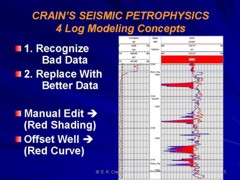|
The velocity of sound in a rock is related to the elastic properties of the rock/fluid mixture and its density, according to the Wood, Biot, and Gassmann equations. The
composite compressional bulk modulus of fluid in the pores (inverse
of fluid compressibility) is: The pore space bulk
modulus (Kp) is derived from the porosity, fluid, and matrix
rock properties: The
composite rock/fluid compressional bulk modulus is: Compressional velocity (Vp) and shear
velocity (Vs) are defined as: Although it is not a precise solution, we often invert equations 5 and 6 to solve for Kb and N from sonic log compressional and shear travel time values. Where:
The Biot-Gassmann approach looks deceptively simple. However, the major
drawback to this approach is the difficulty in determining the
bulk moduli, particularly those of the empty rock frame (Kb and
N), which cannot be derived from log data. Murphy (1991)
provided equations for sandstone rocks (PHIe < 0.35) that
predict Kb and N from porosity: These can help overcome the lack of empty rock-frame data.
Oil
compressibility: Gas
compressibility:
What percent change in velocity could be expected if 75% of the pore space were filled with methane gas? 0.
Convert velocity to cm/sec. 1.
Invert the velocity equation and solve for Kc (sometimes referred
to as the space modulus M) for 100% water-bearing condition. 2.
Determine Km from handbook data. For this example, Km was estimated to be 74.5 * 10^10 dynes/cm2 because the rock was a mixture of limestone and dolomite. 3.
Estimate Kb. 4.
Determine fluid properties at reservoir conditions. Water
density = 1.085 gm/cc. Gas-water
combination properties. Kf
from the Wood equation. 5.
Solve Gassmann equation for Kb at Sw = 100%. 6.
Solve this equation for Kc with combination gas/water conditions. 7.
Solve density equation for gas/water combination. 8.
Solve for Vp for Sg = 0.75. Utilizing this methodology and the stated assumptions, there would be an approximate 10% change in velocity (14,000 - 12,500 / 14,000) from a 100% water saturated zone to one that has identical rock properties but 75% gas saturation in the pore space. As a matter of interest, if the rock frame compressibility were assumed to be 5.0 * 10^-7 psi-1, the computed gas/water-bearing velocity would be 13,100 ft/sec. This is only 7% slower than the observed water-bearing velocity and helps demonstrate the sensitivity of the calculation to the assumption of rock frame modulus.
What
percentage change in velocity could be expected if 75% of the
pore space were filled with methane gas (gas gravity 0.8)? Compressibility
values on poorly consolidated formations are difficult to obtain.
It is believed that many operators are attempting to measure and
catalogue such data. However, most of these data are being held
confidential. The velocity change computed with these assumptions is approximately 34%. However, the computed velocity of 5,370 feet per second, or 186 microseconds per foot, compares reasonably well to observed sonic log values in gas zones having rock and reservoir properties similar to the assumptions made in this calculation. As
a matter of interest if the bulk compressibility of the rock frame
is assumed to be 3.0 * 10^-5 psi-1, or an increase of nearly an
order of magnitude, the computed Gasmann velocity for 75% gas
is 5,000 feet per second. This is an additional 4.5% decrease
in velocity from the water-bearing case.
Solving
the equation:
Solving
the equation: Note
that the result depends largely on the choice of gas pseudo-travel
time, and this is subject to some error in judgment.
|
||
|
Page Views ---- Since 01 Jan 2015
Copyright 2023 by Accessible Petrophysics Ltd. CPH Logo, "CPH", "CPH Gold Member", "CPH Platinum Member", "Crain's Rules", "Meta/Log", "Computer-Ready-Math", "Petro/Fusion Scripts" are Trademarks of the Author |
||


|
||
| Site Navigation | LOG EDITING USING BIOT GASSMANN METHOD | Quick Links |
